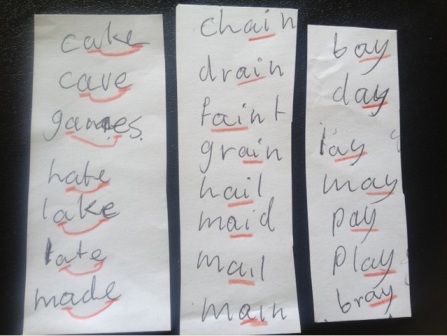Underlining spellings
3 Replies
When teaching spellings while writing, getting learners to mentally group letters which represent a single sound and think of them as a single “chunk” (grapheme) can be tricky.
One way to focus their attention on a target spelling is by asking learners to underline it, for example:
spout out cloud
learn heard pearl
fought brought bought
This quickly shows you whether the learner understands which letters are working together to represent a single sound.
You can also use underlining to differentiate, for example, the “ough” in bought, drought, through, though and thorough (one spelling) and the ough in cough and rough (two spellings):
bought drought through though thorough
cou gh trou gh Gou gh
rou gh tou gh enou gh
The letters “ai” right next to each other are mostly representing a single sound, as in “rain”, “bonsai” and “plait”, but sometimes they’re not, as in “mosaic”, so would not be grouped together by underlining them:
rain bonsai plait said
mosaic algebraic prosaic
In my multi-syllable word workbooks (Level 7 and Level 8), I also like to break words up into syllables using little dots, as many of the learners I work with find it hard to identify syllable boundaries, and often they don’t realise that a syllable can be a single letter, or seven or eight letters:
i·de·a mo·sa·ic de·light streng th·en
This can also help them to see the patterns in longer words, where otherwise the middles of words can be a bit of a blur:
ac·tion lo·tion cau·tion fic·tion
cast·le fast·en list·en whist·le
Unfortunately it’s a bit hard in typed text to underline split vowel spellings like the “a…e” in “take” and the “i…e” in “fine”, but I usually just underline both vowel letters then draw a little loop underneath that joins them, like this:
 Some phonics programs put a loop or arrow over the word rather than under it, to link the two vowel letters.
Some phonics programs put a loop or arrow over the word rather than under it, to link the two vowel letters.
There are also apps which link the letters in a split vowel spelling in this way, such as WriteOn Phonics
Movable alphabets that incorporate multiple-letter spellings, such as my cheap-and-cheerful DIY 100-first-spellings Movable Alphabet, also help learners to conceptualise spellings as the building blocks of words.
If you know of other simple tools or strategies which help learners conceptualise spellings as “chunks”, or resources to help with this which are not on my Phonics Resources list, I’d love to hear about them.




[…] http://www.spelfabet.com.au/2013/09/underlining-spelling/ […]
When the targeted word/letters are underlined, do left-handers underline from left to right (which is natural for them), or right to left?
Hi Tia, that might be a question for an Occupational Therapist, but my usual inclination is to ask kids to always be moving from left to right with the direction of the text. I’m not sure there is a single right/wrong answer though. Alison